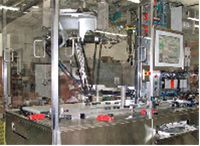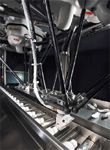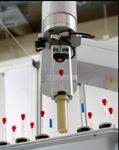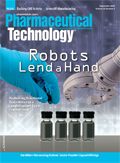Robots: The Next Phase in Pharmaceutical Automation
Robotic systems provide flexibility and efficiency (and they're not as difficult to use as you think). This article contains bonus online-exclusive material.
Drugmakers rely on automated equipment as a matter of course. Yet unlike the food and semiconductor industries, the pharmaceutical industry has been slow to adopt one particular form of automation: robots. The hesitation has partly resulted from a lack of expertise, the perceived high initial cost of robotics, and the misperception that robotic systems are too complex and require complicated programming. But current computer and peripheral systems have increased the capabilities and flexibility of robot technology, and some automation experts predict robots soon could be critical to drug manufacturers' efforts to reduce costs, ensure consistent product quality, and increase efficiency.
Design
A robot is an automated system that incorporates a sensor, an intelligent decision-making algorithm, and an actuator, according to David Barrett, associate professor of mechanical engineering at Olin College in Needham, Massachusetts. Various types of robots have emerged, including selective compliant assembly robot arm (SCARA) robots, articulated-arm robots, and Delta robots that are useful in pick-and-place applications (see Figures 1 and 2).

Figure 1: Pick-and-place robotics template for various configurations.(
Robots fall into two main categories, according to Ève Coste-Manière, independent research scientist and founder of Ève Coste-Manière Consulting. Arm robots mimic the structure of the human arm and are good for pick-and-place functions. Parallel robots comprise a platform mounted on "legs." These systems provide more precision (e.g., for insertion) than arm robots.

Figure 2: A high-speed robot (ABB IRB 360 FlexPicker) picks and places vaccine droppers.(
Generally a robot has at least four axes of motion. "Anything less than that is not really considered a robot or programmable mechanism," says Rick Tallian, a packaging expert at the robotics division of ABB. A robot that provides four to six axes of motion provides the flexibility of movement usually required in a packaging environment, for example.
A pharmaceutical manufacturer must pay particular attention to the robot's end effecter (e.g., its gripper), the part that will come into contact with the product. A company also must consider its sterility requirements and whether the robot will manipulate fragile containers. Engineering help is usually required to design a robot, particularly if it will be installed into a scaled-up process. ABB, for example, employs system integrators who can analyze a specific manufacturing application and develop a custom system around that application. In some cases, the system will be similar to another application so that the engineering content has been worked out, and the system costs less than a custom system.
Current applications
Laboratories. Many tests associated with research, discovery, and development entail repetitive tasks such as moving fluids between wells in a plate. Pharmaceutical laboratories now use robots to perform these tests because they are easy to automate using traditional pick-and-place machines. "Robots provide a high degree of consistency and accuracy executing the test protocols, while at the same time allowing the researcher to focus on higher-value tasks," says Walt Langosch, director of sales and marketing at ESS Technologies.
Equipment vendors have begun providing the industry with laboratory instruments that incorporate robots. For example, SciGene makes a laboratory bench that includes a robot that prepares DNA samples. The laboratory technician does not need engineering skills; he or she can use the robot by following simple instructions, says Brian Carlisle, president and CEO of Precise Automation.
Another example is Varian's auto-sampler, which includes a robot that picks up test tubes and loads them into a nuclear magnetic resonance imaging magnet (see Figure 2). The emergence of vendors such as Varian and SciGene has allowed the pharmaceutical industry to use robots more and more, says Carlisle.
Robots' success in pharmaceutical laboratories has encouraged companies to incorporate the machines into closely related production operations such as pilot and small-batch manufacturing lines. Other companies have made robots a part of their distribution systems.
Packaging. The flexibility of a robotic system is especially useful in packaging applications such as primary packaging, placing primary cartons in a case, and loading the case on a pallet (see Figure 3). Such capabilities are particularly beneficial if a company makes multiple products or different product package configurations on a single production line. For example, if a company makes 60-count containers of tablets and must add to the line to a 300-count container as well, then a robot would be able to handle both package configurations on the line.

Figure 3: A robotic autosampler loads test tubes into an analytical instrument.(
Various primary packaging configurations can also be handled. "If you're packaging in a blister pack from a small dosage all the way to a large capsule, robots allow you to have a quick switchover and do high-speed repetitive moves or motions that, in many cases, an operator cannot handle," says Doug Burns, head of the sustainability group at Rockwell.
Tallian identifies at least two major factors for the increased demand for robotics in packaging. First, some large retail outlets are now demanding different packaging configurations. Instead of, or in addition to, the large-count pill bottles (e.g., 250–300 count bottles) that traditionally have been shipped to a retailer's pharmacy, retailers want smaller-count, easy-to-use configurations so that their pharmacists do not need to handle the product on site.
Second, companies are now adopting track-and-trace capabilities in packaging. "In many cases, replacing human labor in packaging by automation or a robotic system will provide a more error-free operation," says Tallian. "If a company has an operation in which a person picks up a bottle and puts it into a box, a human operator has a chance that a wrong bottle will be placed in the wrong box or the wrong box might be placed onto a wrong pallet. Robotic or automatic systems that can read a barcode scan will know what to do with the product with that particular code."
Potential applications
Although many companies have successfully incorporated robots into pharmaceutical laboratories and packaging, they have been slow to use them for manufacturing applications, says Martin Van Trieste, vice-president of quality at Amgen (Thousand Oaks, CA).
Because it is a repetitive activity that requires great reproducibility to produce a high-quality product, aseptic filling would particularly benefit from robotic automation. "Successful aseptic filling requires impeccable operational discipline to consistently produce sterile products. We also know that the human body is the greatest source of contamination in a pharmaceutical cleanroom. Any technology that can remove the operator from the cleanroom logically will provide for a higher probability of producing a sterile product," says Van Trieste.
In addition, robots could enhance quality assurance and quality control by enabling 100% inspection, which is difficult for humans to achieve. A robotic system consisting of several cameras and a conveyor belt "could actually take a picture of each pill as it goes down the line and kick off any minor, imperceptible flaw, so that only perfect productgets through," says Barrett. Robots can check products for weight, color, or barcodes, he adds.
Criteria for using robots
Robots are not appropriate for every pharmaceutical process, and manufacturers should consider certain criteria to determine where to apply this form of automation. In general, a highly repetitive and highly precise process is a good candidate for roboticization. Many robots perform at high speed and are adapted to high-volume processes. And robots could also perform low-volume operations that completely consume an employee's time.
Quality control is another criterion to consider. "If you want to have a highly repeatable process, particularly if it's a fairly delicate process, robots are extremely repeatable," says Carlisle. Robots also are a good choice in cleanrooms and other operations where contamination must be controlled, he adds. The machines can protect drugs from contamination and shield humans from potentially harmful products or processes.
Drugmakers can seek outside advice when determining when to incorporate robots into their operations. A robotics integrator can perform a line audit and evaluate a company's manufacturing and packaging processes to identify opportunities for robots to improve processes (e.g., by increasing speed, increasing efficiency, reducing rework, and reducing scrap). A robotics integrator can also assess the sophistication and training of operators and maintenance personnel and propose the correct training for the application and the support structure, says Langosch.
The economic case
Before implementing robotic systems, a company must consider their economic implications. The cost of robots, like that of other established technology, has been steadily decreasing. "Replacing a piece of outdated or slower equipment with the flexibility and sustainability of robotic automation makes good fiscal sense," says Langosch.
The cost of implementing robots in pilot production "amortizes itself in a reasonable return-on-investment time," says Barrett. Robots' flexibility allows companies to produce small lots of a drug and to change to a different product quickly without incurring the capital cost of fixed-price automation. "That makes it very viable, especially for vendors that are working on genomically targeted drugs and niche markets," says Barrett.
On the other hand, robotics would probably be far more expensive at the consumer-product scale than setting up the process line would be. "If it's going to cost you $2 billion to build your factory and produce aspirin, then the cost per aspirin is very low. If you can't guarantee you have that quantity per year, then it's economically more viable to do it with robotic automation," says Barrett.
Sometimes robots can be deployed strictly to reduce costs. But pharmaceutical companies can find more opportunities for robots to improve product quality and employee safety, adds Van Trieste.
Others argue that adding robots to pharmaceutical processes usually makes good economic sense. "By taking into account increases in productivity and efficiency and reduction in scrap, garments, rework, and manpower cost, the cost of robotic automation is often justified," says Langosch.
Installing and controlling robots
The easiest way to install a robot is to buy a process that already includes one. When this is not possible, a drugmaker must buy a robot or design one that is appropriate for its process. In either case, the company will likely need the help of a mechanical engineer and a software engineer. Manufacturers of robotic systems "have made great strides with their software and tools, making implementation easier," says Van Trieste.
Usually, a robot is installed into a work cell. "Robots are completely compatible with other unit operations and packaging equipment," says Langosch. A mechanical engineer can help the company adapt the workcell to accommodate the robot. A software engineer can write a program that controls the robot and allows it to communicate with the other instruments in the cell. During installation, manufacturers should follow guidelines for guarding and safety such as the American National Standards Institute's RIA R15.06-1999 Robot Safety Standard, says Langosch.
After a robotic system has been installed, a robotics engineer must test each part of it to ensure that it performs correctly and is programmed appropriately. All human–machine interfaces must also be checked. In general, companies only make minor modifications to the system after it has been installed. Manufacturers should periodically check the performance of their robotic systems after installation Figure 2: A high-speed robot (ABB IRB 360 FlexPicker) picks and places vaccine droppers.to verify that they're performing properly.
Constant and consistent preventive maintenance is critical to ensure that robots perform well. Companies should establish a preventive-maintenance schedule and look for problems such as leaks and wear on pulleys, gears, or moving parts.
Installing a robot is usually no more complicated than installing most packaging machines, and a robotic integrator can address problems that arise during the process, says Langosch.
Many of the major robotics manufacturers have their own application software package, which makes control easier than writing lines of program. For example, ABB's Pickmaster ease-of-use programming package is presented in a drag-and-drop Windows environment that develops about 95% of the robot software without having to write the software.
Traditional robotics use a dedicated robot controller, but there are options where one can integrate control of the robot directly into the main line controller. "That is what we have been promoting," says Bob Hirschinger, product marketing manager at Rockwell. "Often we have primary line control with our control products and we've added capability to those controls that allow us to directly control robotics without the need for the dedicated robotics controller. A broad range of transforms and high level robotic functions facilitate fast and easy integration of robots."
"In pharma applications, it also makes validation easier on the machine because you can integrate control of the robot into the machine controller so you can have integrated recipe management and integrated calibration. It is much easier to collect track-and-trace data," says Burns.
Validating robotic systems
Validating robotic systems is not much different from validating other types of pharmaceutical automation and much easier than validating human interactions with a process, says Van Trieste. The validation process varies according to the product and the process.
Robot vendors often test their products, the process, or the software, and run repeatability tests. "If the pharmaceutical manufacturer wants to develop a new process using a robot, then they will have to qualify it themselves to their standards," says Carlisle. Qualification requirements vary depending on whether the process is simple (e.g., moving packages) or complex (e.g., sample screening, analysis, and data maintenance).
Good manufacturing practice requires robots' software to be qualified, tested, and protected against unauthorized modifications. Large robotic systems include two controllers—a programmable logic control and a robotic controller—and each must be validated, says Langosch.
Cleanroom robots
Robots were once a source of contamination, but major manufacturers such as ABB and FANUC have adapted their products for cleanroom use. For example, these vendors use special paint to reduce electrostatic force and particluate generation. Some designs incorporate vacuum systems that are directly connected to the robots' joints to keep particles away from the process, says Coste-Manière. Other robotic arms are wrapped in surgical-gown material to provide the same protection. Most cleanroom robots have a brushless-motor design featuring components that roll instead of scraping together. This design does not generate carbon dust.
If a robot is intended to perform aseptic processing, the pharmaceutical manufacturer can wipe it down after it is received. Robots now are made of materials that withstand cleaning agents used for instruments in pharmaceutical laboratories. One particular FANUC robot resists decontamination with hydrogen peroxide. And many end effecters and actuators are autoclavable, says Barrett.
Robots are available with positive- and negative-pressure features, and they can be installed inside a laminar-flow hood, says Carlisle. To prepare the robot, manufacturers perform a pumpdown process, the length of which varies according to the level of cleanliness that the application requires.
The semiconductor industry has deployed robots for many years and has even stricter standards for particulates than the manufacturers of sterile pharmaceuticals do, says Carlisle. Semiconductors are sensitive to certain chlorides and other molecules that robots might emit. "It's possible that certain pharmaceutical processes might have that kind of requirement, but I haven't heard of any to date," says Carlisle.
In general, pharmaceutical companies can easily find robots clean enough for cleanroom applications. "I see no increased regulatory risk associated with the implementation of well designed, properly implemented, and validated robotic systems that operate in a robust manner," says Van Trieste.
Benefits
Incorporating robots into pharmaceutical processes has many advantages. Robots can perform operations three or four times faster than humans and can function 24 hours per day, says Barrett. These characteristics make robots good at producing large quantities of products efficiently. By performing simple, repetitive tasks, robots can free employees for creative work such as developing new products.
"Robots can move to a precision of a fraction of the thickness of a sheet of paper," says Carlisle. Their accuracy in positioning, delivering materials, and quantification exceeds humans' ability.
The typical robotic system uses fewer parts, has a quicker changeover process, requires less preventive maintenance, and entails a lower annual operating cost than conventional equipment, says Langosch. A robot often can perform the functions of several pieces of conventional equipment, thus reducing the footprint of the process in the manufacturing space.
Many types of automation cannot be modified easily and are limited to particular products or processes. These machines may lose their utility if a given product is discontinued, but robots can be retooled and reprogrammed for new applications.
Variability can be greatly reduced through the use of robots, which can be programmed to perform exactly the same way every time. This repeatability and reduced variability can lower the pharmaceutical industry's cost of making drugs and improve product quality. If a robot is equipped with machine vision, it can provide "100% process verification and graceful error recovery for high uptime," Langosch says.
Small contract packagers are just as likely to use robots as Big Pharma because robots provide the same advantages to both kinds of companies, says Langosch. The only difference is that Big Pharma would likely achieve a faster return on its investment.
The pharmaceutical industry, in turn, is favorable to robotic systems because its processes generally require low forces, take place in clean environments, and include predictable sets of operations. A robot has a lifetime of millions of cycles in a pharmaceutical process because "there's nothing there to wear it out," says Barrett.
Vision systems
The increasing capabilities of computer systems are extending the applications of robotics as well. As Tallian observes, vision systems can now perform color analysis with better resolution at high speeds, which provides a large amount of data that robots can analyze quickly. "Ease-of-use software wouldn't be possible if we hadn't seen 10 times more power with our computers in the last five or 10 years," says Tallian. "Computer processing power has been a huge launch of robotic systems. There has been a lot of change in the mindset of the manufacturers, and more are now willing to consider a robotic automated system than in the 1990s or early 2000s."
Burns says his company sees many robotic applications that include vision systems as a key component. "We see, for example, many pick-and-place applications where you have random product and you have a vision system that detects the product position and feeds that to the control system which then determines where to pick the part and where to drop it. And we see applications where there are multiple robotics or cooperative robots picking product off a single line."
Robotics and sustainability
Like other industries, the pharmaceutical industry is increasingly concerned with the sustainability of its operations. To improve their sustainability, drugmakers are attempting to reduce waste and pollutants, conserve energy, and improve efficiency. Robots can help the industry achieve these goals. For example, robots' motors, drives, and gearboxes are 90–95% energy efficient, says Barrett.
Robots reduce waste in manufacturing processes, too. Because they perform highly repeatable processes, robots decrease variability and ensure high product quality. This quality assurance reduces the amount of rejected products and wasted materials. Robots can thus reduce pollution and save companies money on ingredients, says Coste-Manière.
Robotic packaging processes are more flexible than conventional ones because they offer consistent, gentle handling, are reprogrammed easily, and require few change parts. This flexibility gives designers great freedom to reconfigure packages and use lightweight or recyclable materials, says Langosch. Well-designed robotic systems offer high reliability and uptime, low maintenance requirements, and fast changeover, thus resulting in high overall equipment effectiveness. "These benefits create an environment where the packaging-line utilization factor contributes to the customer's sustainability goals," says Langosch.
Robots also are compatible with disposable components, which can improve process sustainability by reducing cleaning requirements and the water and chemical consumption that they entail. Several laboratory systems such as the Tecan system use disposables in combination with robots. Personnel can attach single-use parts such as plastic pipette heads to a robot's end effecter. The end effecter can control the pipetting action, and the tip can be discarded.
"People associate robots as being a very expensive mode of manufacturing," says Tallian. "Energy consumption is actually very low. Sometimes people consider them to be hazardous, but robots have been around since the mid 1970s, so they have become very reliable."
Burns says his company identifies three "pillars of sustainability" in robotics: energy, environment (waste reduction), and safety. Several machines in pharmaceutical manufacturing include many mechanical parts that exert a lot of energy to get the movement that is needed. "Those mechanical systems are very inefficient, so the energy savings is toward a much more efficient power transmission ratio of power to movement. That is, first and foremost, one of the big sustainable outputs that you get."
A robot's ability to make different movements and have different motion profiles also helps reduce waste that a machine produces during setup or production. Finally, one of the concerns about robotics is maintaining a safe working envelope around a machine for an operator. A robotic system helps ensure a safe work environment so that an operator cannot intrude into the robot's area of operation.
Conclusion
Economic conditions are raising the stakes and intensifying the competition in the pharmaceutical industry. Drugmakers are intently seeking ways to reduce their expenses, increase their efficiency, and make high-quality products. Robots can help companies achieve these ends by providing speed, precision, repeatability, and flexibility. Because they can improve discovery, pilot production, and small-scale production, robots can be a particularly powerful foundation for the growing biotechnology industry, says Barrett.

Pharmaceutical Tariffs Are Imminent: How Industry is Bracing for Impact
April 16th 2025On April 14, 2025, the Trump Administration launched a national security-driven investigation into pharmaceuticals, a move that will likely result in tariffs being placed on pharmaceutical drugs, ingredients, and other components that are imported from outside of the United States.